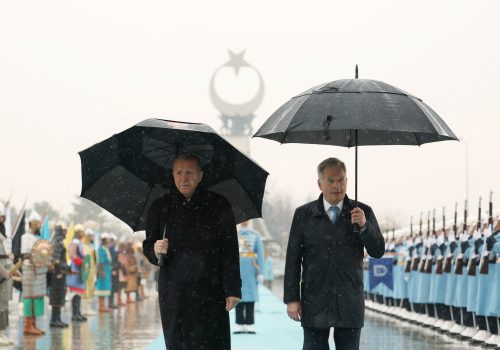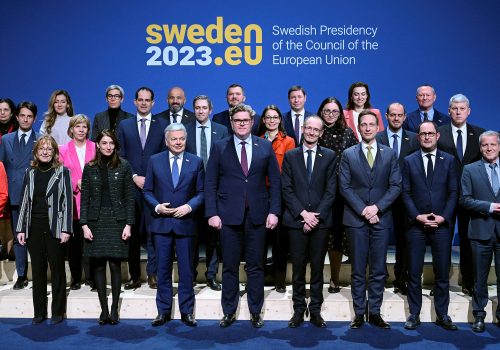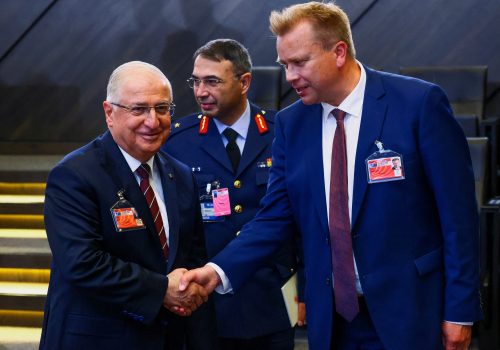Navigating Sweden’s NATO membership: Insights for political and operational adaptation
Table of contents
I. Introduction
Sweden is on the cusp of joining Finland as NATO’s newest members, bridging a crucial gap in the region’s security architecture and creating new opportunities for closer security cooperation. Once Sweden is in NATO, the Baltic Sea will be a geographically coherent strategic space—or, in more casual parlance, a “NATO lake.” That this is happening at the same time the Alliance is renewing its purpose and focus on the frontline states along its northern and eastern flanks is not a coincidence, but it is nonetheless a key development in how NATO is developing its deterrence against an aggressively revanchist Russia.
It is commonly believed that Sweden will strengthen the Alliance’s overall defense and deterrence posture, especially as it relates to securing northeastern Europe. Expectations for Sweden, which has been a close NATO partner for years and is seen as one of the most staunchly reliable countries in the transatlantic community, run high.1Alexandra de Hoop Scheffer, Martin Quencez, and Gesine Weber, “Transatlantic Trends 2023,” German Marshall Fund of the United States, September 12, 2023, https://www.gmfus.org/news/transatlantic-trends-2023. At the same time, institutional and operational integration into NATO will require a significant rethinking of Swedish defense policy that heretofore has been focused on self-defense rather than collective defense. Stockholm will need to grapple with the complex implications of becoming a member of a large alliance—as its neighbor Finland is currently learning—to find its voice and value over time.2Steve Erlanger, “Finland Raced to Join NATO. What Happens Next Is Complicated,” New York Times, September 25, 2023, https://www.nytimes.com/2023/09/25/world/europe/finland-nato-integration-nordics.html. As a close observer of Finland’s accession process, however, Stockholm might be able to take a page from the Finnish playbook.3Charlie Duxbury, “‘The Time Has Come.’ Sweden Gets Ready for NATO Membership,” Politico, October 26, 2023, https://www.politico.eu/article/sweden-nato-membership-jens-stoltenberg/.
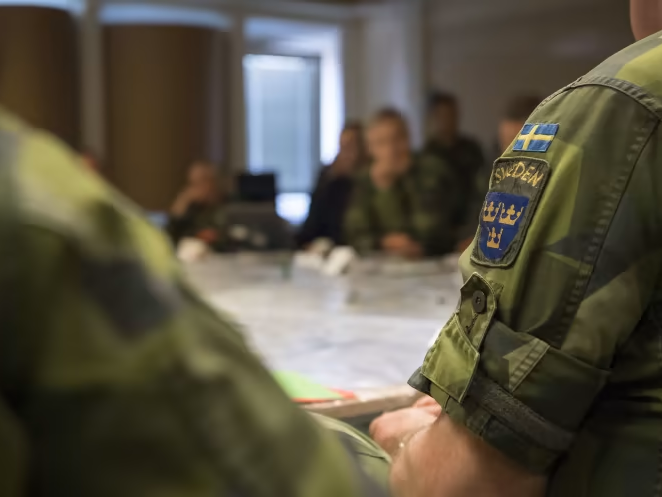
II. The new threat environment
At the height of Cold War, nonaligned and self-reliant Sweden was an important military player in Northern Europe and possessed one of the most advanced armed forces in the region.4Bengt Sundelius and Jan Eldeblad, “Societal Security and Total Defense: The Swedish Way,” National Defense University, March 10, 2023, https://ndupress.ndu.edu/Media/News/News-Article-View/Article/3323928/societal-security-and-total-defense-the-swedish-way/. However, as the geopolitical landscape drastically changed in the 1990s and Russia’s perceived danger diminished, Sweden—along with other Western nations—made massive military budget cuts and dismantled its military defense. Many of the Cold War-era military capabilities, capacities, and practices were not retained and were consequently lost, while Swedish defense was remodeled for participation in international missions. A discernable shift in the other direction began with Russia’s illegal annexation of Crimea in 2014, which came as a shock, set in motion a series of deterrence and defense measures, and deepened bilateral defense agreements—a shift dubbed the “Hultqvist doctrine.”5Anna Wieslander, “‘The Hultqvist Doctrine’—Swedish Security and Defence Policy After the Russian Annexation of Crimea,” Defence Studies 22, 1 (2021), 35–59, https://www.tandfonline.com/doi/full/10.1080/14702436.2021.1955619.
Russia’s full-scale invasion of Ukraine in February 2022 permanently and fundamentally altered the security environment in Europe, including dramatically changing the nature of Russia’s threat to Sweden.
According to Swedish Defense Minister Pål Jonson, Sweden finds itself in “the most serious security policy situation since the end of World War II.”6“Swedish Government to Increase Defence Spending amid NATO Bid,” Associated Press, September 12, 2023, https://www.euronews.com/2023/09/12/swedish-government-to-increase-defence-spending-amid-nato-bid. The return of large-scale, high-intensity combat to Europe cemented Russia’s aggressive intentions and revealed the stark contrast between the limits of NATO partnership and the security guarantees of NATO’s Article 5, driving Sweden to its historic decision to pursue full NATO membership. Although Sweden has maintained close cooperation with NATO for decades, nonaligned Sweden would need to contemplate a scenario of defending its territory and fighting Russia alone or in partnership with Finland.“7Relations with Sweden,” NATO, last visited November 29, 2023, https://www.nato.int/cps/en/natohq/topics_52535.htm. That would have required a full spectrum of Swedish defense capability, which was dramatically limited by the modest amount Stockholm was willing to spend on defense. Inside NATO, Sweden’s threat assessment will change. All littoral Baltic Sea countries will be covered by NATO’s collective security guarantees, and the uncertainty about what would happen in the case of an armed attack on Sweden will decrease. Once in NATO, Sweden will also come under the Alliance’s nuclear umbrella. With that, Sweden’s approach to nuclear weapons will shift from one focused on arms control and disarmament to one that must directly contemplate nuclear deterrence.
At the same time, a potential escalation of the war in Ukraine has become of increased importance to Sweden, as the risk that Sweden might need to fight Russia as part of the Alliance has increased in tandem. The Swedish Defense Commission, tasked by the Swedish government with reevaluating Swedish security policy and laying the groundwork for a new Swedish security strategy, considers “Russia as the most serious long-term threat to Europe’s and Sweden’s security” in its June 2023 report.8“The Swedish Defence Commission Submits Its Report on Sweden’s Security Policy to Minister for Defence Pål Johnson,” Sweden Ministry of Defence, June 19, 2023, https://www.government.se/articles/2023/06/the-swedish-defence-commission-submits-its-report-on-swedens-security-policy-to-minister-for-defence-pal-jonson. To that end, the commission submitted a report to continue the redevelopment of Sweden’s Cold War-era total-defense concept, which combines efforts of the armed forces, civilian organizations, and the private sector in response to an attack within the country.9“Swedish Defence Commission,” Sweden Ministry of Defence, last updated April 20, 2023, https://www.government.se/government-of-sweden/ministry-of-defence/defence-commission/; “Swedish Defence Commission submits total defence report,” Sweden Ministry of Defence, December 19, 2023, https://defence-industry.eu/swedish-defence-commission-submits-total-defence-report/.
Despite war losses in Ukraine, Russia is highly likely to remain an enduring military threat in the Baltic Sea region and the Arctic for the foreseeable future. Sweden is routinely subject to Russian gray-zone activities under the threshold of war, including air-space violations and disinformation efforts. Russia’s stoking of Islamophobic activities inside Sweden to undermine Sweden’s NATO bid is a recent chilling example.10Miranda Bryant, “Russia Spreading False Claims about Qur’an Burning to Harm NATO Bid, Says Sweden,” Guardian, August 6, 2023, https://www.theguardian.com/world/2023/aug/06/russia-spreading-false-claims-about-quran-burnings-to-harm-nato-bid-says-sweden. Although Baltic Sea security architecture is being strengthened and reinforced, the threat landscape has become unstable and less predictable. Notably, the NATO Strategic Concept no longer rules out a Russian attack against Alliance territory.11“NATO 2022 Strategic Concept,” NATO, June 29, 2022, https://www.nato.int/nato_static_fl2014/assets/pdf/2022/6/pdf/290622-strategic-concept.pdf. Russia maintains air superiority in the Baltic Sea region and could establish anti-access/aerial denial (A2/AD) bubble over the Baltic states, which would be extremely costly to defeat. Reconstitution of Russia’s depleted land forces is inevitable, and it might happen faster than allies might assume.
III. Sweden’s geography and defense capabilities
As noted earlier, there is common belief that Sweden will strengthen the Alliance’s overall deterrence posture and contribute reliably to collective defense activities, even as the obligation to defend the Swedish homeland increases NATO’s liabilities. This section will briefly review the practical reasons behind this thinking and provide an overview of Sweden’s imagined practical value to NATO.
Geography. Mainland Sweden has the longest Baltic Sea coastline of any country in Europe, which will allow the Alliance to strengthen its influence over and military control of the Baltic Sea. Sweden serves as a link between Denmark in continental Europe; Finland and Norway in the north; and Estonia, Latvia, and Lithuania across the Baltic Sea. It geographically connects the High North, the North Atlantic, and the Baltic Sea in ways that allow for a coherent and integrated defense of the entire region.12Ruby Mellen, Dylan Moriarty, and Julia Ledur, “Four Maps Explain How Sweden and Finland Could Alter NATO’s Security,” Washington Post, July 11, 2023, https://www.washingtonpost.com/world/2023/07/11/nato-sweden-finland-maps/; “Overbefalhavarens rad Avseende Svenskt Natomedlemskap,” Forsvarsmakten, October 31, 2022, https://www.forsvarsmakten.se/contentassets/e41b11744f404ba1b60255c66b8a3ca1/underbilaga-1-1-overbefalhavarens-rad-svenskt-natomedlemskap.pdf. To that end, Swedish territory will give NATO more strategic and operational depth, make lines of communication more resilient, and provide options to defense planners to use Swedish territory for defense and deterrence missions.
Of note when discussing Swedish geography is the large and centrally located island of Gotland in the Baltic Sea. In peacetime, Gotland can play a role in enhancing NATO’s control of the Baltic Sea. In a crisis, Gotland is likely to be a factor in defending the Baltic states against a Russian attack. Viewed militarily as the unsinkable “aircraft carrier” during the Cold War, Gotland was demilitarized in 2005. After Russia’s mock attack on Sweden in 2013 and its annexation of Crimea in 2014, Stockholm has reestablished a military presence on Gotland, which now includes a regiment of four hundred troops, a mechanized battalion with CV90 armored vehicles and Leopard 2 tanks, a Home Guard amphibious battalion, and an air-defense missile system.13David Cenciotti, “Russia Simulated a Large-Scale Aerial Night Attack on Sweden,” Business Insider, April 23, 2013, https://www.businessinsider.com/david-cenciotti-russia-simulated-a-massive-aerial-attack-2013-4; Anna Wieslander and Eric Adamson, A Glimpse of Sweden in NATO: Gotland Could Be a Game-Changer for Baltic Defense, Atlantic Council, April 26, 2023, https://www.atlanticcouncil.org/blogs/new-atlanticist/a-glimpse-of-sweden-in-nato-gotland-could-be-a-game-changer-for-baltic-defense/. Air-defense systems were brought back to the island and reactivated in 2021.14“Gotland Air Defence Is Reinforced,” Swedish Armed Forces, March 17, 2022, https://www.forsvarsmakten.se/en/news/2021/03/gotland-air-defence-is-reinforced/. After Russia’s full-scale invasion of Ukraine in February 2022, Gotland saw increased patrolling, a $160-million investment to rebuild military infrastructure, and robust military exercises.15Anna Ringstrom, “Sweden Boosts Patrols on Gotland amid Russia Tensions,” Reuters, January 14, 2022, https://www.reuters.com/world/europe/sweden-boosts-patrols-gotland-amid-nato-russia-tensions-2022-01-13/; “Sweden to Boost Military on Gotland amid Russia Fears,” Reuters, April 29, 2022, https://www.reuters.com/world/europe/sweden-boost-military-gotland-amid-russia-fears-2022-04-29; James Brooks, “Swedish, US Troops Drill on Remilitarized Baltic Sea Island,” Associated Press, June 12, 2022, https://apnews.com/article/russia-ukraine-sweden-nato-finland-c52ddae2f753ba3ea210316201bc6105; “Defence Exercise Aurora 23,” Swedish Armed Forces, last visited November 29, 2023, https://www.forsvarsmakten.se/en/activities/exercises/aurora-23/.
In the case of any future confrontation between NATO and Russia, Gotland is likely to play a critical role. It would be a logical target for Russia to contest, or even seize, as a means of forward deploying air-defense systems to utilize its A2/AD capabilities in the Baltic Sea, complicating NATO’s access to the Baltic states.16Robert Dalsjo, Christofer Berglund, and Michael Jonsson, “Bursting the Bubble: Russian A2/AD in the Baltic Sea Region: Capabilities, Countermeasures, and Implications,” FOI, March 2019, https://www.foi.se/rest-api/report/FOI-R–4651–SE. With territorial defense still being rebuilt and only one regiment currently available to defend Gotland, Stockholm should consider further expanding its own military presence and infrastructure, while inviting other NATO allies to deploy their forces to the island for training and familiarization.
Defense resources. Sweden does not currently meet NATO’s target to spend 2 percent of its gross domestic product (GDP) on defense, but is on track to reach the 2-percent goal in 2024—two years earlier than originally envisioned.17“Major Investments in Military Defence and NATO Targets Projected to Be Reached,” Government Offices of Sweden, September 11, 2023, https://government.se/press-releases/2023/09/major-investments-in-military-defence-and-nato-targets-projected-to-be-reached; “Sweden’s Supreme Commander Says Defence Spending to Reach 2% of GDP by 2026,” Reuters, November 1, 2022, https://www.reuters.com/world/europe/swedens-supreme-commander-says-defence-spending-reach-2-gdp-by-2026-2022-11-01/. To that end, the Swedish government announced in 2023 that the defense budget will increase by 28 percent, or $2.49 billion, to $11 billion in 2024.18“Sweden to Boost Defence Spending Next Year by Almost 30%,” Financial Times, September 11, 2023, https://www.ft.com/content/d1afa268-a59b-4299-9b27-b8d716819417. The increased resources will focus on investments on Swedish Armed Forces’ personnel, military innovation, and development and defense materiel, as well as larger contributions to Swedish activities related to NATO’s deterrence and defense missions.19“Major Investments in Military Defence and NATO Targets Projected to Be Reached.” This is part of a broader Swedish effort to increase its defense budget to rebuild capacity after decades of underinvestment in defense. However, as allies at NATO’s Vilnius Summit redefined the target of 2 percent of GDP as a floor and not a ceiling, Stockholm should expect pressure to continue its upward trajectory.20“Vilnius Summit Communiqué,” NATO, press release, July 11, 2023, https://www.nato.int/cps/en/natohq/official_texts_217320.htm.
At a time when many national defense champions are struggling to meet growing demand for arms production to replenish depleting stockpiles, Sweden’s indigenous industry, including companies such as Saab and Ericsson, can serve as a boost for NATO’s industrial efforts. For a country of its size, Sweden has a substantial and competitive defense industry, which has historically relied on domestic development and production of advanced defense equipment, including submarines and fighter aircraft.21Peter Nordlund, “Sweden and Swedish Defence—Introduction to the Special Issue,” Defence and Peace Economics 33, 4 (2022), 387–398, https://www.tandfonline.com/doi/epdf/10.1080/10242694.2021.2003529?needAccess=true. Besides covering domestic needs, Swedish defense companies are export-oriented, and will be able to forge partnerships and bid for NATO procurement projects once the country joins the Alliance.22Tom Waldwyn, “Sweden’s Defence Industry: NATO Membership Promises New Markets but Poses Challenges,” International Institute for Strategic Studies, August 4, 2023, https://www.iiss.org/online-analysis/military-balance/2023/08/swedens-defence-industry-nato-membership-promises-new-markets-but-poses-challenges2/. Swedish defense-industrial capacity can help allies backfill material sent to Ukraine and meet the Alliance’s growing stockpiling targets.
Armed Forces. The Swedish active-duty armed forces declined dramatically from 180,000 troops during the end of the Cold War to 14,700 professional soldiers and 11,400 reserve soldiers in 2022. Since conscription was reconstituted in 2017–2018, the number of conscripts has been gradually increasing, with 5,000–6,000 people enrolled every year and a projection to reach ten thousand recruits annually between 2030 and 2035.23“Mål: 10 000 Värnpliktiga före 2036,” SVT Nyheter, December 23, 2022, https://www.svt.se/nyheter/snabbkollen/mal-10-000-varnpliktiga-fore-2035. Recruitment efforts are under way to build back up to fifty thousand troops. The progress is tangible, but slower than desired to meet the increased demand for Swedish defense, especially given that it is becoming increasingly difficult to recruit conscripts to pursue a professional military career after their compulsory service.24“Supreme Commander: Not Enough Conscripts Staying in Swedish Armed Forces after Military Service,” Radio Sweden, January 16, 2023, https://sverigesradio.se/artikel/supreme-commander-not-enough-conscripts-staying-in-swedish-armed-forces-after-military-service. The Home Guard of approximately twenty-one thousand men and women is quite small compared to that of Finland.25“Home Guard: Society’s Soldiers,” Swedish Armed Forces, November 29, 2023, https://www.forsvarsmakten.se/en/about/organisation/home-guard. These personnel increases will help defend the Swedish homeland in the context of a NATO-Russia war. But as Sweden takes on additional NATO responsibilities for the defense of Finland and the Baltic states—including the deployment of ground forces as part of NATO’s enhanced Forward Presence (eFP) missions—a larger land force seems necessary.
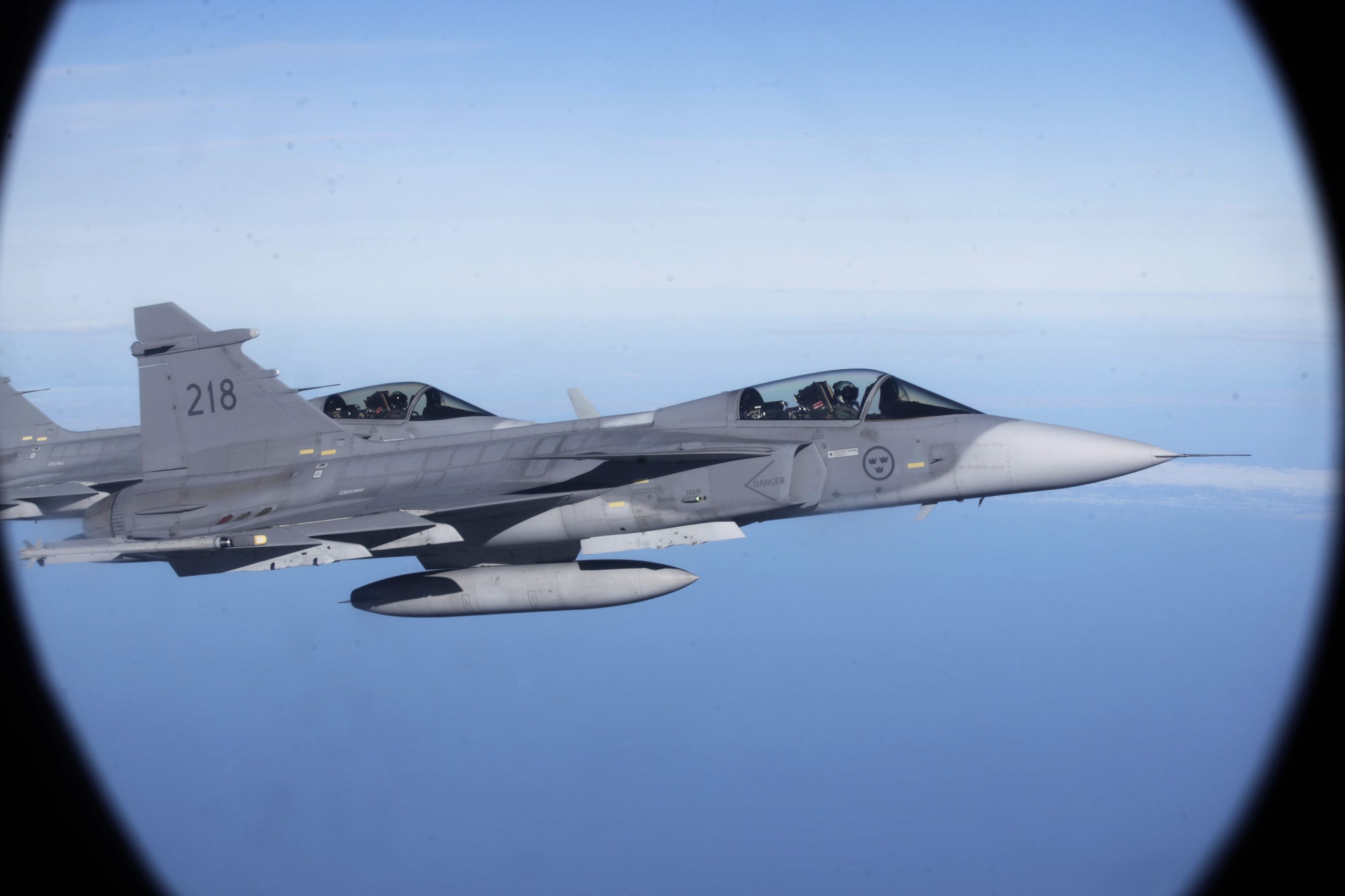
Air defense. The Swedish Air Force is commonly viewed as Sweden’s strongest military service. With more than ninety domestically manufactured multi-role JAS 39 Gripen jets in active service, Sweden will lend considerable air capability and technical knowhow to NATO. However, with many NATO allies, including neighbors Finland and Norway, partners in the US-led F-35 program, the Swedish Air Force will be an outlier from a platform perspective.26John Hill, “Sweden Stands as Outlier of the Newly Merged Nordic Air Force,” Airforce Technology, March 29, 2023, https://www.airforce-technology.com/features/sweden-stands-as-outlier-of-the-newly-merged-nordic-air-force/?cf-view&cf-closed. Integrating Sweden’s Gripen jets with NATO’s F-35 fleet, and ensuring interoperability in terms of communications and role specialization, should be a top priority for both Sweden and NATO. This will entail decisions about whether the Swedish Air Force should use the F-35’s battle-management capabilities to direct Gripen pilots and about the size of the Gripen fleet needed for NATO’s long-term force mix. The agreement among the Nordic countries to operate their approximately 250 fighter jets as a joint operational fleet and to provide air policing for Iceland will serve as a proving ground for these types of decisions.27Gerard O’Dwyer, “Nordic Nations Move to Link Air Forces into 250-Strong Aircraft Fleet,” Defense News, March 24, 2023, https://www.defensenews.com/global/europe/2023/03/24/nordic-countries-move-toward-linking-their-air-forces-250-planes/.
Missile defense. A credible air- and missile-defense system is an essential element of NATO’s deterrence and defense in the Baltic Sea region. Sweden and Denmark recently joined fifteen NATO allies—including Finland, Norway, and the Baltic states—in the 2022 German-led European Sky Shield Initiative (ESSI), which aims to enhance European air-defense capabilities through the common acquisition of interoperable, off-the-shelf air-defense solutions.28“European Sky Shield Initiative Gains Two More Participants,” NATO, February 15, 2023, https://www.nato.int/cps/en/natohq/news_211687.htm; “14 NATO Allies and Finland Agree to Boost European Air Defence Capabilities,” NATO, October 13, 2022, https://www.nato.int/cps/en/natohq/news_208103.htm. NATO could build upon Sweden’s existing short-range air defense (SHORAD) and medium-range capabilities as part of its integrated planning, which might also require deployment of allied missile-defense systems and anti-drone systems on Swedish soil.29Anna Wieselander, Eric Adamson, and Jesper Lehto, “Securing Northern Europe within NATO: Sweden and Finland as New Allies,” Atlantic Council, February 2022, https://www.atlanticcouncil.org/wp-content/uploads/2023/02/Securing-Northern-Europe-within-NATO.pdf.
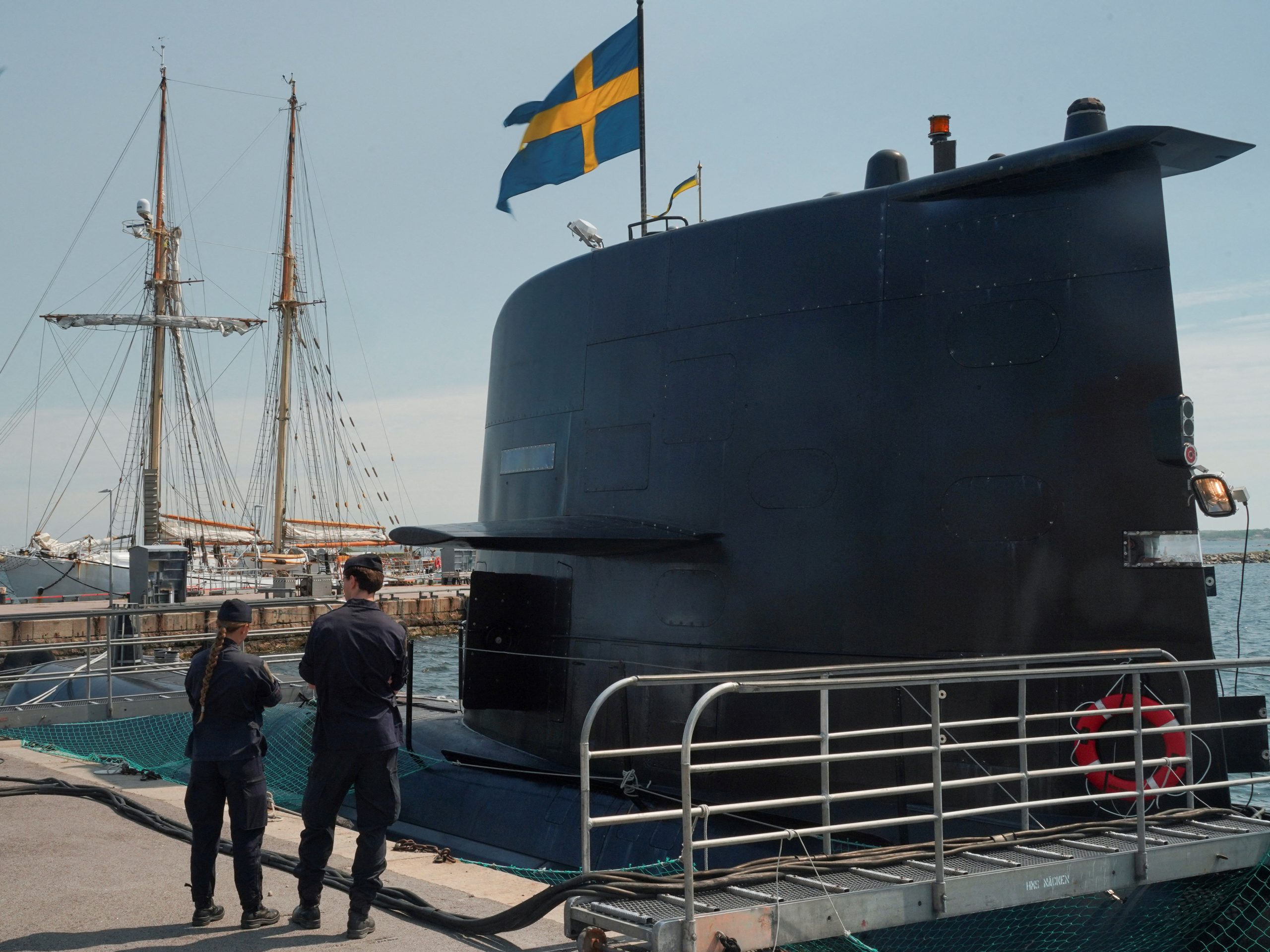
Navy and coastal defense. Although Sweden is most likely to share naval responsibilities in the Baltic Sea with Finland, Poland, Germany, Denmark, and the United States, its regional maritime knowledge and advanced capabilities are crucial assets for NATO in increasingly contested Baltic waters. Currently, Sweden’s naval capacity consists of Gotland-class submarines, Visby-class corvettes, minesweepers, an intelligence ship, and marine amphibious regiments, with new investments on the way to replace older ships.30Xavier Vavasseur, “Saab Signs Two Contracts for Next Generation Corvettes for Sweden,” Saab, press release, January 25, 2021, https://www.navalnews.com/naval-news/2021/01/saab-signs-two-contracts-for-next-generation-corvettes-for-sweden/; Martin Manaranche, “Saab Awarded Contract to Expand Capabilities of A26 Blekinge-Class Submarine,” Saab, press release, August 27, 2021, https://www.navalnews.com/naval-news/2021/08/saab-awarded-contract-to-add-capabilities-on-future-swedish-submarines. The three diesel-powered Gotland-class submarines are a particularly important asset for the NATO underwater operations in the Baltic Sea. In contrast to the blue-water submarines owned by many allies, Swedish submarines are adapted to function in the shallow brown waters of the Baltic Sea. Recent incidents, such as Nord Stream pipeline explosions and manmade damage to a gas pipeline and a telecommunications cable connecting Finland and Estonia, have reaffirmed that seabed warfare is intensifying and the Baltic Sea is becoming a target of deliberate acts of sabotage.31Jari Tanner, “Damage to Gas Pipeline Telecom Cable Connecting Finland and Estonia Caused by ‘External Activity,’” Associated Press, October 10, 2023, https://apnews.com/article/finland-estonia-pipeline-24d6623cf2778464fdb4ef1d85c70d91. Protecting thousands of miles of undersea cables, which remain subject to Russian cyber and kinetic attacks, is a major challenge for NATO.32Sabine Siebold, “NATO Says Moscow May Sabotage Undersea Cables as Part of War in Ukraine,” Reuters, May 3, 2023, https://www.reuters.com/world/moscow-may-sabotage-undersea-cables-part-its-war-ukraine-nato-2023-05-03/. Robust private-public cooperation is necessary, especially because a fair share of the cables are privately owned. While NATO has established a NATO Maritime Centre for the Security of Critical Undersea Infrastructure under NATO’s Maritime Command and an undersea infrastructure-coordination cell in response to the attacks on Nord Stream pipeline, these measures have proven insufficient to ensure necessary protection.33“NATO Steps Up Baltic Sea Patrols after Subsea Infrastructure Damage,” NATO, October 19, 2023, https://www.nato.int/cps/en/natohq/news_219500.htm; “NATO’s Maritime Activities,” NATO, August 3, 2023, https://www.nato.int/cps/en/natohq/topics_70759.htm. Swedish undersea capabilities, especially underwater sensors and submarines, as well as Sweden’s familiarity with Baltic waters, could play a significant role in monitoring and enhancing the protection of regional critical infrastructure.34Anna Wieselander, Eric Adamson, and Jesper Lehto, “Securing Northern Europe within NATO: Sweden and Finland as New Allies,” Atlantic Council, February 2022, https://www.atlanticcouncil.org/wp-content/uploads/2023/02/Securing-Northern-Europe-within-NATO.pdf.
Cyber. As evidenced by Russia’s ongoing cyber operations against NATO, starting with landmark cyberattacks against Estonia in 2007, Russia employs a variety of cyberwarfare tactics and constitutes a major cyber threat to the allies. Sweden, as one of the few European countries developing offensive cyber capabilities, brings to the table a capable cyber-defense force.35John R. Deni, Sweden Would Strengthen NATO with Fresh Thinking and an Able Force, Atlantic Council, May 18, 2022, https://www.atlanticcouncil.org/blogs/new-atlanticist/sweden-would-strengthen-nato-with-fresh-thinking-and-an-able-force/. The Swedish Armed Forces have recently established a new cyber unit to boost their capacity “to wage armed combat in the cyber arena,” which is expected to be fully operational by 2027.36“Nytt it-Försvarsförband Stärker Sveriges Cyberförsvarsförmaga,” Försvarsmakten, January 12, 2022, https://www.forsvarsmakten.se/sv/aktuellt/2022/01/nytt-it-forsvarsforband-starker-sveriges-cyberforsvarsformaga/. Stockholm should consider how to effectively integrate its cyber capabilities into NATO’s Cyberspace Operations Centre and volunteer cyber effects to Alliance missions.
IV. Navigating Sweden’s future in NATO
As is clear from the accounting in the previous section, Sweden will bring a significant number of resources—geographic, financial, industrial, and operational—to NATO. In addition to its well-regarded capabilities on the political and policy levels, where Sweden is expected to bring considerable energy, expertise, and moral authority, expectations are high for Sweden once it becomes a member of NATO. How that manifests, however, and what it means for NATO’s overall deterrence posture will be a function of decisions made in Brussels, Mons, Stockholm, and elsewhere. What role NATO’s operational planners see for Sweden and its current and future military capabilities in the Alliance’s regional plans will be sorted out through NATO’s Defense Planning Process (NDPP). How the Swedish political and defense establishment sees these questions matters too, as is true for every ally. What follows are some political and operational considerations for Stockholm as it navigates the form and function of its NATO membership.
A. Finding Sweden’s political voice and value
When thinking about the most effective allies inside NATO, different types of ambition and influence come to mind. The United States has influence because of the size of its resources and its global political standing. The United Kingdom, France, and Germany have influence as the largest economies and militaries in Europe. Plenty of allies wield limited influence or are influential only in terms of what they oppose, rather than by building a positive agenda. Still other allies exert outsized influence because of their ability to bring unique ideas, energy, or capabilities to the table. Norway’s prominence on Arctic issues, for instance, comes to mind. There are also allies that, by virtue of strong agency around a particular issue, band together to push the NATO agenda. The Baltic states and Poland have been successful advocates for eFP and more intensive defense planning along NATO’s eastern frontier.
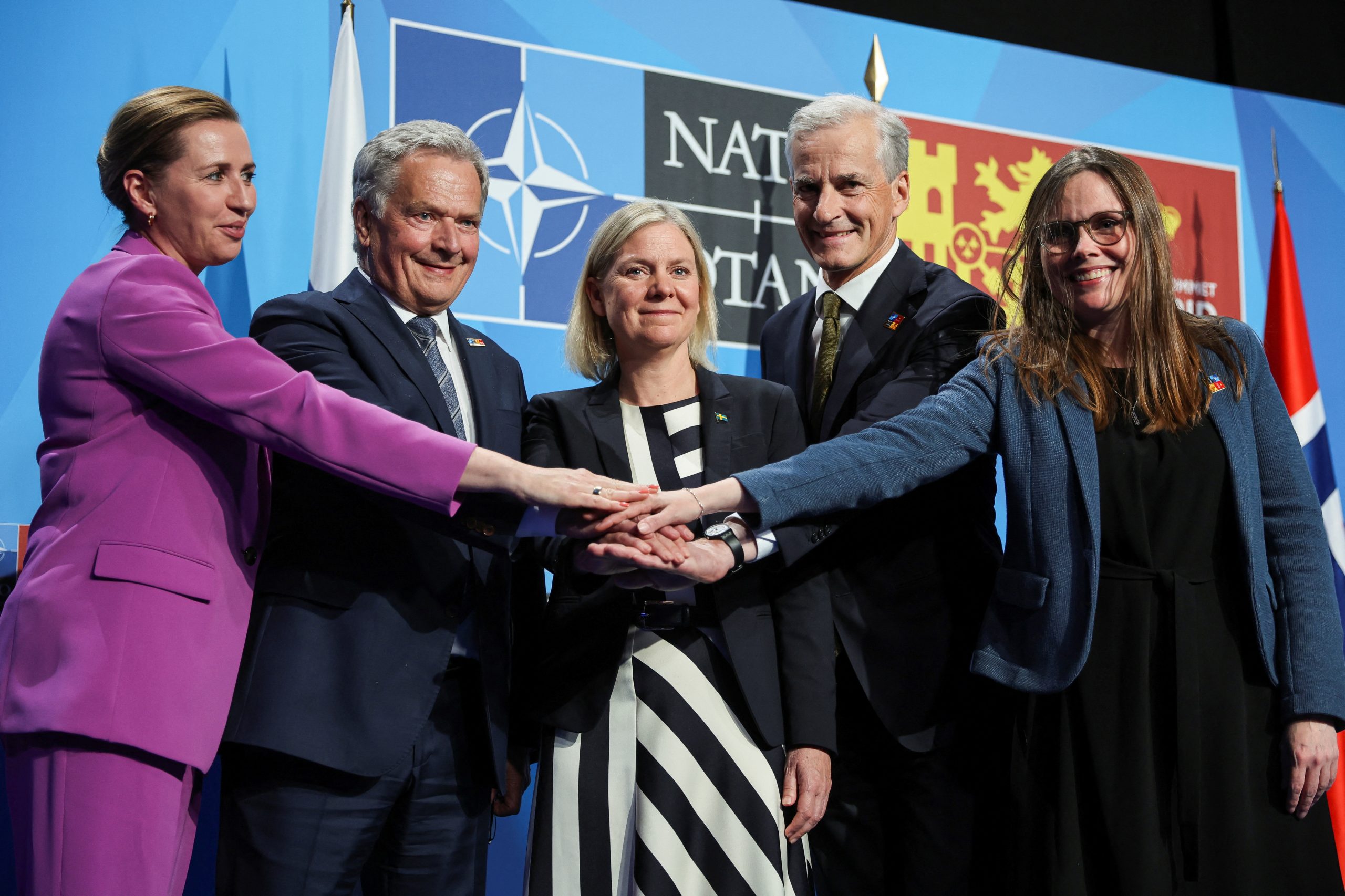
As membership integration efforts accelerate in the coming months, Sweden can reference these models to navigate the shape of its membership. While the US model or those of the major European powers aren’t available to Sweden, other good options exist and many allies will be eager to partner with Sweden to build influence inside the Alliance. As Stockholm considers its approach to membership, it should build its political strategy concentrically in the following ways to build value and impact inside NATO.
Finland. Sweden’s defense cooperation with Finland has “special status.”37“Statement of Government Policy in the Parliamentary Debate on Foreign Affairs Wednesday 16 February 2022,” Government of Sweden, 2022, https://www.government.se/globalassets/government/dokument/utrikesdepartementet/statement-of-foreign-policy-20222.pdf. This is a natural partnership for both Stockholm and Helsinki, and one forged in an unprecedented way as partners of NATO before their decisions to apply for membership. The operational and defense planning work Sweden and Finland did together with the United States and NATO after Russia’s invasion of Crimea in 2014 is seen as the gold standard for that type of joint planning. And, of course, shared geography between the countries requires working together closely on planning and operations, which has been the case for many decades. This is to say that Sweden’s partnership with Finland has credibility and standing inside NATO and can be leveraged to shape NATO priorities. Moreover, the process of taking national self-defense plans and turning them into NATO collective-defense plans is unique to Sweden and Finland, and will require uniquely close cooperation.
Nordics. Norway and Denmark have strong reputations for leadership inside the Alliance and offer good models for becoming respected and impactful NATO nations. The prospect of Norway, Denmark, Iceland, Sweden, and Finland working together inside NATO offers exciting possibilities. A fully formed Nordic bloc could become a power center of sorts for the Alliance, especially on issues related to the High North, sea lines of communication, intelligence sharing on Russia, and deterrence for the Baltic Sea region.
Nordic-Baltic. NATO’s focus in Europe is shifting decisively to the east and north as a reaction to Russian actions and intentions. It will be important for Sweden to think in Nordic-Baltic terms to harden regional deterrence. Swedish and Finnish membership in NATO brings opportunities for defense and deterrence for the Baltic states, arguably the most stressing planning consideration the Alliance faces. The intention to deploy Swedish armed forces to the Baltic states is a significant gesture that recognizes this reality.
Nevertheless, tensions are already playing out between Nordic and Baltic blocs in the debate around command arrangements for NATO operations. While ultimately a decision for the Supreme Allied Commander Europe (SACEUR), there is a sense that the Nordics prefer a maritime-focused command-and-control (C2) arrangement based out of Allied Joint Force Command Norfolk, while the Baltic states and Poland prefer a land-focused C2 arrangement based out of Allied Joint Force Command Brunssum.38Stephen Erlanger, “Finland Raced to Join NATO. What Happens Next Is Complicated,” New York Times, September 25, 2023, https://www.nytimes.com/2023/09/25/world/europe/finland-nato-integration-nordics.html. These types of debates are inevitable as Sweden integrates into the Alliance and illustrative of the challenge for Stockholm of balancing the Nordic perspectives with those of the Baltics and Poland.
The success of the model or models Sweden chooses will, to a degree, depend on practical aspects of NATO membership, which involve contributing a full complement of personnel to Sweden’s mission to NATO, NATO’s international staff, and NATO’s international military staff. Finding Sweden’s voice inside the Alliance will be tied to its understanding of, and influence in, NATO’s elaborate political and military structures—from NATO headquarters in Brussels, to NATO military commands afield, to NATO agencies and affiliated centers of excellence. This will require not just a significant investment of personnel and resources in Brussels, but a significant increase of personnel in Stockholm to manage and provide guidance around Sweden’s increased responsibilities.
B. Achieving Sweden’s strategic and operational alignment
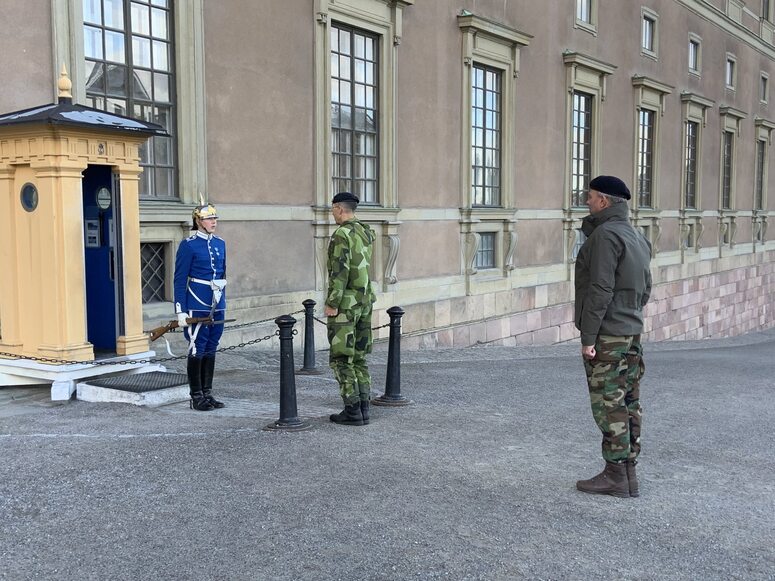
Sweden’s strategic and operational alignment comes at a time of NATO’s “biggest transformation…for decades,” as the Alliance adapts its deterrence and defense posture to blatant Russian aggression in Europe and threats manifesting from multiple domains.39“UK Joins International Partners in Delivering Air Defence Equipment to Ukraine,” UK Ministry of Defence, press release, June 15, 2023, https://www.gov.uk/government/news/uk-joins-international-partners-in-delivering-air-defence-equipment-to-ukraine. At the 2022 NATO Summit in Madrid, a wholly transformed NATO force posture was approved in response to Russia’s full-scale invasion of Ukraine. The cornerstone of NATO’s ongoing adaptation of its deterrence and defense posture is the 2020 Concept for Deterrence and Defense of the Euro-Atlantic (DDA). The DDA Concept sets a new comprehensive framework that links allies’ military strategies with the overall deterrence and defense efforts of NATO. To implement the DDA Concept, SACEUR has drafted a new generation of military plans, including a strategic plan that covers the entirety of Alliance territory, supported by regional plans and subordinate plans for seven domains: air, land, maritime, space, cyber, special operations, and reinforcement. This requires an unprecedented level of military planning in the modern NATO era.40Three regional plans were approved at the Vilnius Summit in 2023, covering the High North and Atlantic; the Baltic region and central Europe; and Southeast Europe, including the Mediterranean and Black Sea.
Executability of these regional plans is essential for effective defense and deterrence of the entire Alliance, including the Baltic Sea region. By aligning national defense plans of frontline nations with NATO plans, regional plans enable the movement of NATO forces to the right place at the right time and the conduct of large-scale operations to defend every inch of the Alliance’s territory.41C. Todd Lopez, “SACEUR Provides Update on Deterrence, Defense of Euro-Atlantic Area,” US Department of Defense, May 10, 2023, https://www.defense.gov/News/News-Stories/Article/Article/3391802/saceur-provides-update-on-deterrence-defense-of-euro-atlantic-area/. As a result, they assign each NATO country specific responsibilities for the defense of a region of the Alliance. In addition, the regional plans, which NATO uses as the baseline for the NDPP, set objective, threat-based requirements that guide the capability development of national forces in a crisis or conflict.42“NATO Chiefs of Defence Discuss Executability of Regional Plans,” NATO, last updated September 18, 2023, https://www.nato.int/cps/en/natohq/news_218538.htm.
As a NATO partner, Sweden has long participated in the Planning and Review Process (PARP) under the auspices of the NATO’s Partnership for Peace (PfP) initiative. Additionally, when Sweden gained “invitee” status on July 5, 2022, NATO and the Swedish Ministry of Defense began to integrate Sweden into the Alliance’s defense planning process by including Sweden in non-nuclear NATO activities and providing interim capability targets for Swedish planning purposes.43“Relations with Sweden,” NATO, last updated April 12, 2023, https://www.nato.int/cps/en/natohq/topics_52535.htm; “Sweden’s path to NATO membership,” Government Offices of Sweden, last updated April 5, 2023, https://www.government.se/government-policy/sweden-and-nato/swedens-road-to-nato/; “Defense and Society’s Crisis Preparedness,” Swedish Parliament, January 2023, https://data.riksdagen.se/dokument/HB031d7. However, NATO operational planners will soon be able to count on Sweden’s full participation and capabilities in NDPP, while Swedish military planners should expect increased demands on their armed forces’ capacity. Given its geographic location, Sweden is likely to be heavily involved in the plans for the Atlantic and European Arctic, as well as the Baltic region and Central Europe.
For the first time, all the Nordic and Baltic countries will have the same security arrangements based on NATO’s common-defense planning. In addition to homeland defense, Swedish armed forces may acquire responsibility for defense in depth of Finland, for control of the northern Baltic Sea, and for reinforcement of the Baltic states. Sweden would not only contribute forces for defense of the Alliance, but also invest in host-nation support. This could include the prepositioning of ammunition and weapons stocks, and the improvement and increased protection of infrastructure to support military sustainment and mobility.
Sweden’s realignment will also include transitioning to a new NATO Force Model (NFM), which is intended to replace the current NATO Response Force and provide a pool of three hundred thousand troops on higher readiness. The NFM calls for allies to collectively allocate several hundred thousand troops across land, sea, air, and cyber domains, who will be pre-assigned to specific plans for the defense of NATO.44“New NATO Force Model,” NATO, last visited November 29, 2023, https://www.nato.int/nato_static_fl2014/assets/pdf/2022/6/pdf/220629-infographic-new-nato-force-model.pdf. Adaptation to the ambitious force model will place significant demands on the small Swedish military, which is potentially expected to contribute a brigade of five thousand troops.45“Kallor: NATO Vill ha Svensk Armetrupp pa 5 000 Soldater,” Dagens Nyheter, May 19, 2023, https://www.dn.se/sverige/kallor-nato-vill-ha-svensk-armetrupp-pa-5-000-soldater/. To that end, Sweden should continue increasing the size of its army, which cannot happen overnight and will require dedicated additional personnel for education and training. Yet, Stockholm must strike a balance between providing enough forces to NATO initiatives, including its large-scale readiness and integration exercises, while still having the necessary number of troops required to conduct planning, training, and other functional responsibilities to maintain its national force and increase end strength.
Finally, NATO membership will require Sweden to be forward leaning and incorporate evolving NATO concepts such as Multi-Domain Operations (MDO). Ukraine’s use of Starlink and other commercial space capabilities to defend against Russia’s unprovoked and brutal attack has demonstrated that today’s warfare requires military and nonmilitary instruments of power to work together.46Ann Marie Dailey, NATO Needs a Plan for Military and Nonmilitary Instruments of Power to Work Together, Atlantic Council, November 2, 2023, https://www.atlanticcouncil.org/blogs/new-atlanticist/nato-needs-a-plan-for-military-and-nonmilitary-instruments-of-power-to-work-together/. MDO marks a major change in NATO’s approach to military activities, which necessitates greater integration of all operating domains and environments, as well as synchronized action with nonmilitary actors.47“Multi-Domain Operations in NATO—Explained,” NATO, October 5, 2023, https://www.act.nato.int/article/mdo-in-nato-explained/. This means that, as part of a broader transition, the Swedish Armed Forces will need to shift their focus from operating primarily as a national military in a joint environment to operating as a member of a multinational force under NATO during potential multidomain operations.
Overall, aligning Swedish defense planning with NATO’s regional plans will be a challenging and resource-intensive task.
The nature of Sweden’s future responsibilities and its role in NATO regional plans are to be negotiated with SACEUR. Once Sweden gains full membership status, Stockholm can count on thirty-one allies to assist in any conflict or war with Russia, it can afford a higher degree of role specialization. It could be that Sweden’s advanced air capabilities, or its submarines, corvettes, and minesweepers are deemed the highest priority for NATO. To that end, three critical recommendations will help Sweden achieve strategic and operational alignment with NATO.
- First, mastering the NDPP’s five steps are key, and Sweden should lean on NATO international staff to build knowledge and ensure integration with the NDPP.48“NATO Defence Planning Process,” NATO, last updated March 31, 2022, https://www.nato.int/cps/en/natohq/topics_49202.htm. Step five of the NDPP, “Review Results,” is of particular note, as it provides a robust mechanism to assess the incorporation of NATO plans into national planning, and conversely, how national plans impact NATO plans. This review takes place every two years through the Defence Planning Capability Survey, which can be used as a benchmark for Sweden to gauge the impact of its national planning as it seeks to integrate into NATO’s larger framework.
- Second, Sweden should lean on Nordic Defense Cooperation (NORDEFCO) to enable cooperation on acquisition. As Sweden is already a member of NORDEFCO, it can beneficially work within that existing framework to align acquisition strategies with those of other NATO nations to accelerate its integration into the broader NATO framework.
- Third, Sweden should improve its acquisition processes through intensified testing and experimentation. The iteration and exercise of capabilities in simulated combat settings can provide valuable information prior to acquisition, ensure a more seamless adoption process, and reduce planning time.
V. Conclusion
Sweden’s membership in NATO should strengthen the transatlantic community at a turbulent moment. In fact, only a severe and unexpected shock like Russia’s invasion of Ukraine could have driven the Swedish political establishment to abandon its policy of nonalignment and apply for NATO membership. Sweden has the advanced military capabilities, defense-industrial base, and political and operational sophistication to be an impactful ally quickly. Its geography matters, too, and will contribute to a more coherent and integrated defense of the Baltic Sea region.
However, translating Swedish resources into Alliance assets will require a philosophical shift from self-reliance and homeland defense to collective forward defense. This is a significant barrier for Sweden to overcome in achieving impact inside NATO, especially as allies will expect Sweden to be capable of contributing to collective defense outside Sweden’s borders in line with NATO’s 360-degree approach to deterrence and defense.49“Deterrence and Defence,” NATO, October 10, 2023, https://www.nato.int/cps/en/natohq/topics_133127.htm. As it looks to accelerate its transition into NATO, Sweden will need determined political and operational strategies, using different models and groupings to shape its political integration, while mastering NATO planning processes so that it can adapt its forces and capabilities to respond to the Alliance’s growing demands and to confront Russia’s enduring military threat.
Authors
Acknowledgement and disclaimer
The Atlantic Council has drawn insights from two workshops on the impact of NATO’s Nordic enlargement to the Baltic Sea security the Atlantic Council hosted in the autumn of 2023. The authors wish to thank workshop participants and reviewers of the issue brief for their thoughts and idea. In addition, the authors would like to thank Anna Wieslander for her review of this report.
This publication was produced in partnership with Sweden’s Ministry of Foreign Affairs under the auspices of a project focused on transatlantic security.
Related content
Related program

The Transatlantic Security Initiative, in the Scowcroft Center for Strategy and Security, shapes and influences the debate on the greatest security challenges facing the North Atlantic Alliance and its key partners.



